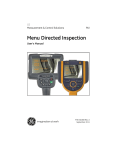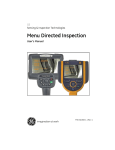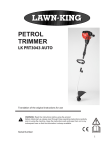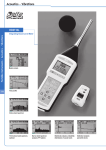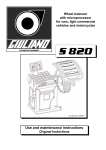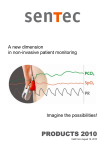Download Porti 8 user manual
Transcript
Table of Contents 1. Introduction.........................................................2 1.1. Assigned Purpose:............................................2 1.2. Accessories......................................................2 2. Information..........................................................3 2.1. Safety-related information.................................3 2.2. General information..........................................3 2.3. Technical inspection.........................................4 2.4. Liability for functioning or damage....................4 3. Recording measurement data using the Porti unit............................................................................4 3.1. Sensors.............................................................4 3.1.1. Sensors for flow and snoring noises.....................4 3.1.2. Thermistor sensor for breathing............................4 3.1.3. Sensor for CPAP/Bilevel-pressure........................4 3.1.4. Sensor for oxygen saturation and pulse frequency .........................................................................................5 3.1.5. Sensor for thorax and abdominal movement........5 3.1.6. Sensor for body position.......................................5 3.1.7. Sensor for leg movement......................................5 3.1.8. Sensor for ECG.....................................................5 3.1.9. Sensor for Neuroport............................................5 3.1.10. Sensors for EEG / EOG / EMG...........................6 3.2. Preparing for measurement (Ambulatory)........6 3.3. Attaching the Porti unit and starting the measurement............................................................6 3.4. Online Measurements (Inpatient)......................7 4. Service and Maintaining the device..................7 4.1. Charging the battery.........................................7 4.2. Cleaning instructions........................................7 4.3. Maintenance.....................................................7 4.4. Transport and storage conditions.....................7 5. Evaluation software for PC................................7 5.1. Installing the software.......................................7 5.2. Selecting a printer.............................................8 6. Troubleshooting.................................................8 7. Ordering informations........................................9 8. Technical specifications..................................10 9. Used Symbols...................................................10 10. Index.................................................................11 11. EC-Declaration of conformity........................12 REV 2014-11-17 -1- 1. Introduction • • • 1.1. Assigned Purpose: The Porti 8 Sleep Diagnosis System is a recording system for outpatient and clinical use. It serves as a differentiated diagnosis for the sleep apnea syndrome. The Porti unit enables continuous recording of up to 40 channels for at least 15 hours without loss of data. It records signals for the following physiological variables: • • • • • • • • • • Flow Oxygen saturation SpO2 Pulse frequency Pulse wave Body position Respiratory and snoring sounds CPAP pressure Ambient Light Thorax effort Abdomen effort optional: • Splitter box for connecting the Leg sensors • ECG electrode for recording ECG signals • EEG electrode for recording the forehead EEG signals • Splitter box for connecting the EEG/EOG/EMG signals • Thermistor for additional breathing detection • Analogue Input Connection (incl. Splitter Box) The data can be displayed and analysed on a standard commercial PC. The measurement curves and the analysis results can be printed on all commonly available printers, including dot-matrix, laser or ink jet printers. The OR5 (Online Recording) analysis program has the following minimum configuration requirements: • • optional: • Thermistor • 6 x ECG • Central heart Frequency • PTT (Pulse Transit Time) • Systolic Blood Pressure • 3 x EMG (Leg movement, Chin) • Neuroport (Frontal EEG) • 6 x EEG • 2 x EOG • 8 x Analogue channel • • • • • • • 1.2. Accessories The SleepDoc Porti system as a whole contains two components: • The microprocessor controlled Porti recording device • PC software for measurement data presentation and PC analysis It is also equipped with the following accessories: • • • • • • • Battery recharger Shoulder bag for storing the Porti unit Transport case USB Interface cable for data transfer between the Porti unit and PC SpO2 finger sensor with cable for obtaining pulse frequency and oxygen saturation values Velcro strap for securing the finger sensor to the wrist Flow prongs for obtaining the respiratory signal. The 20 cm long adapter hose is identified by a blue ring Adapter hose for measurement during CPAP Therapy Flexible carry belt with integrated pressure transducers (thorax effort) to fasten the Porti unit to the patient Flexible belt with integrated pressure transducer to record abdominal effort PC with Windows operating system Microsoft Windows XP, Windows Vista, Windows 7, Windows 8 512 MB of RAM (2 GB recommended) 1 GB of disk space on the hard drive CD-Rom drive for installation Mouse 128 MByte VGA graphics card with a resolution of at least 1024 x 768 (512 MB, 1280 x 1024 / True Colour recommended) Free USB port Printer with Windows driver This manual is intended to give the operator and user general information on how to safely handle and operate the SleepDoc Porti device. It also explains the intended use of the unit, the different sensors and connections. The next chapter guides you through the PC software installation followed by a troubleshooting guide should you encounter any problems with the SleepDoc Porti device. Technical specifications, spare parts and accessories list and an index complete the manual. -2- 2. Information 2.1. Safety-related information Observe the instruction manual: Every use of the device requires exact knowledge and observance of this instruction manual. The device is only intended for the use described herein. Patient instruction: Patient instruction must only be carried out by the doctor or staff authorized by that person. The enclosed quick reference cannot take the place of the manuals instructions and warnings about possible hazards. Do not open the device! Warning: For online measuring you must use an electrical or optical isolator for connection of the device to the PC (available from your home care provider). A connection of the device to the PC without electrical or optical isolator is only allowed if all patient connections have been removed first. Only Physicians or trained staff is allowed to perform online measurements. Warning: Magnetic and electrical fields can impact on the functioning of the device. When operating the device, ensure that all third-party devices being operated in the vicinity are meeting their relevant EMC requirements. X-Ray equipment, HF surgical devices, tomography devices etc. can interfere with other devices as they may emit higher levels of electromagnetic interference. Warning: The device has no defibrillator protected application parts. A direct application of the device to the heart (esp. ECG!) is not allowed. Warning: Using multiple devices for patient screening could result in excessive leakage current above the allowed value! Warning: Using the device together with pacemakers can result in disturbances of the pacemaker or the device. Warning: Applying the device to more than one patient at any one time is not allowed. Warning: When applying sensors to the patient, please ensure that no electrical line of the device is in contact with any other electrical conductive parts including ground. Warning: Avoid placing this instrument in direct sunlight or in close proximity to intense heat. Prevent also the contact with dust, lint, dirt, moisture and liquids. Warning: Children or incompetent persons should not use this device unattended without first having obtained instructions for the safe use of the device. Ensure that infants, children and animals cannot touch the device unattended 2.2. General information This instruction manual should be regarded as a component of the device. It should be kept on hand somewhere near the device at all times. Reading and understanding the instruction manual is a prerequisite for proper use and correct handling of the device in order to maintain the safety of the patient and operator. The guarantee is valid for a period of 24 months for the device and 6 months for the equipment from the date of sale. Only accessories which are listed in this instruction manual should be used with the device. We cannot guarantee the safe operation and function of the device if unknown proprietary accessories / consumables are used that have not been tested. (E.g. Patient leads, Sensors, Consumables, Memory cards etc.) Damages resulting from the use of third-party accessories or consumables shall render this warranty void. The manufacturer will only assume responsibility for the device in terms of safety, reliability and function if: 1. assembly, add-ons, reinstallation, changes and repairs are carried out by the manufacturer or a qualified agent authorized by the manufacturer to do so; -3- 2. The device is used in accordance with the instruction manual. All printed material relates to the model of the device and the safety regulations at the time of printing. All devices, switches, processors, software programs and names contained herein are subject to copyright law. to those parties. F&G shall not be liable for damages arising from non-observance of this instruction manual. The actual guarantee and warranty conditions in the F&G terms of sale/delivery are not extendable. F&G shall only be liable for the malfunction of the device and its software if used in the normal operating conditions in accordance to this manual. 3. Recording measurement data using the Porti unit If a PC is included in delivery third party software is not allowed to be installed on this PC. 3.1. Sensors Medical devices must only be operated by a qualified experienced person(s) to ensure correct handling of such devices. 3.1.1. Sensors for flow and snoring noises The operator must read and understand the user manual to operate the device correctly. The operator must check the functionality of the device before each use to ensure it is in sound condition and in good working order. Functional testing of the device must be carried out at regular intervals. It is recommended that this is conducted once a month. Upon reaching the end of its service life, the device and its accessories should be disposed of in accordance with the WEEE Directives or relevant Electronic Disposal protocol. For further details please contact Dr. Fenyves and Gut. 2.3. Technical inspection Only devices that are regularly checked and maintained are deemed safe to use. It is recommended that units are subject to a test protocol and the battery is replaced every 24 months. For more details on servicing and service contracts, please contact the F&G Customer Service Department or your service provider The following tests need to be carried out by the operator before each measurement: • • • • • • • Visual inspection of the device and accessories for obvious damage which could result in mechanical failure. Testing all hose connections are air tight. Testing the thorax and abdominal sensors for leaks. Checking the display LEDs. Testing the pulse and SpO2 finger sensors and carrying out a plausibility test (timed pulse test using). Checking the CPAP pressure. Testing the battery capacity. 2.4. Liability for functioning or damage In the event of improper use or repair by the owner or operator, the liability for the device will be transferred The detection of patient flow is determined by the use of a nasal flow prong that transmits the pressure signal to an internal pressure transducer of the device. The flow prong can be easily applied by the user and will have no adverse affect on the quality of sleep. The use of a flow prong also eradicates the problem where adhesive sensors cannot be used. (i.e.: patients with beards). In addition the flow prong is an economical choice of sensor as it is commonly available. No additional sensor is required for respiratory and snoring detection. Respiratory sounds are transmitted to the Porti unit via the flow prong. The built in microphone detects the sounds which are then electronically analysed. Therefore additional microphones are not required. Due to the high sensitivity of the internal pressure transducer, the Porti device is capable of measuring and recording ultra fine pressure differences associated with patients who mouth breathe. In order to connect the flow prong, ensure the blue connector of the prong attaches into the blue connector of the device. The flow prong should be used in accordance with the manufacturer’s instructions. Warning: The flow prong is intended for single patient use. No attempt should be made to clean or use the flow prong the more than once. Multiple use can result in cross infection! 3.1.2. Thermistor sensor for breathing Additional to the flow prong a Thermistor can be used to measure the breathing. Please also observe the instructions accompanying the sensor. The brown connector of the Thermistor needs to be attached to the brown connector on the Porti unit. 3.1.3. Sensor for CPAP/Bilevel-pressure When performing measurements on a patient undergoing CPAP therapy, an adapter hose is used instead of the flow prong. -4- The blue connector of the CPAP adapter needs to be attached to the blue connector on the Porti unit. side, Right side, Upright. 3.1.7. Sensor for leg movement 3.1.4. Sensor for oxygen saturation and pulse frequency A pulse oximeter has been integrated into the Porti device for the purpose of measuring oxygen saturation and pulse frequency. When using a finger sensor, please use the Velcro wrist/armband to secure the sensor and cable. The use of adhesive tape to secure the sensor may result in allergic reactions to the patient, adhesive residue damaging the sensor, loss of data. Please ensure that blood circulation at the point of measurement is not affected by the manner in which the sensor has been secured. All nail polish (coloured or clear) must be removed from the measuring finger to obtain useable data. Please read and understand the instructions accompanying the finger sensor. 3.1.5. Sensor for thorax and abdominal movement To diagnose restless or periodic leg movements (restless leg), the Porti device can be equipped for each leg with a sensor and internal recording software (optional). The device then enables continuous recording of leg movements and associated analysis results in the report. Attaching the leg sensor: All commonly available types of electrodes with 1.5mm safety plugs can be used for both bipolar EMG channels. To connect the electrodes to the device the splitter box is used. The yellow marked connecting plug of the splitter box needs to be plugged into the yellow socket on the Porti unit. For application and cleaning of the electrodes please refer to the manual of the manufacturer. For long time electrodes a very careful preparation of the skin is necessary! 3.1.8. Sensor for ECG The sensors used for recording thorax and abdominal movement consists of small rubber pressure pads that are connected to the Porti device via measuring hoses. The sensor for recording thorax movement comprises of two pressure pads whereas the sensor for abdominal movement contains only one. The sensors are inserted into the pockets of the elasticated effort belts. The thorax belt is applied at the height of the sternum, the abdominal belt in the stomach region. The supplied ECG cable (optional) is compatible with all commonly available adhesive electrodes and can be used as consumables. Attaching the ECG electrodes: For hygiene reasons and to avoid allergic reactions the belts should be worn over clothes. The red connector of the thorax sensor needs to be attached to the red connector and the black connector of the abdominal sensor needs to be attached to the black connecor of the device. The effort belts are adjustable in size due to the Velcro fasteners, and should be suitable for most patients. These belts are however also available in special sizes. Note: Overstretching of the belts may result in poor signals and possible loss of data. The red marked connecting plug of the EEG electrode cable needs to be plugged into the red socket on the Porti unit. 3.1.9. Sensor for Neuroport The Neuroport signal is obtained via the supplied EEG cable (optional). We recommend special 3-part EEG electrode strips as consumables. The position sensor integrated in the Porti unit displays information related to the patient’s body position during the study. The 3 part EEG electrode strip needs to be applied to the forehead. Before applying the electrode the forehead must be cleaned with a sterile solution. A headband around the forehead will eliminate movement of the electrode during the study. For accurate determination of body position, ensure the Porti device is applied to the patient correctly. The body positions detected are: Supine, Prone, Left The blue marked connecting plug of the EEG electrode cable needs to be plugged into the blue socket on the Porti unit. 3.1.6. Sensor for body position -5- on the cable. 3.1.10. Sensors for EEG / EOG / EMG For the neurological channels (EEG, EOG, EMG) all commonly available types of electrodes with 1.5mm safety plugs can be used. To connect the electrodes to the device the splitter box is required. The green plug of the splitter box has to be connected to the green socket of the device. For application and cleaning of the electrodes please refer to the manufacturers instructions. 3.3. Attaching the Porti unit and starting the measurement In order to ensure reliable recording of data, you need to observe the following points when attaching the Porti unit and sensors. Before ambulatory measurements these steps should be demonstrated and practised with the patient beforehand in the clinic: Note: In order to guarantee good adhesion of the electrodes and strong frequency signals, clean the desired skin area with a sterile solution and apply a good quality conductive cream 1. If applicable, attach the ECG electrodes. 2. Secure the Porti unit to the thorax using the elasticated thorax belt (with the two built in pockets). Apply the belt whilst in the standing position and exhale. A correctly fitted belt should not slip up or down once fastened. To record abdominal breathing, attach the abdominal belt (with the single built-in pocket) around the stomach in the same way. Always ensure the belts are fitted over the night clothes and not directly onto bare skin. 3.2. Preparing for measurement (Ambulatory) In preparation of an ambulatory study where the patient will use the device at home, please ensure the following: 1. Charge the battery: (see Page 7). 2. Connect the Porti unit with the USB interface cable. 3. Start the Porti software on the PC. 4. Fill out the fields relating to personal data of the patient in the menu item ”Porti / Porti Initialisation“ (or select the following tab button ) and start the transfer. 5. Switch on the Porti unit by sliding the switch to the right. For self testing purposes, both LEDs will light up initially. The red LED will then go off. The green LED on the Porti unit will remain lit for the duration of the initialization process. 6. In the next step of the Initialization process, you have the option to choose Timer Controlled or Manual recording. 3. Check the position of the pressure transducers (black rubber pads). The sensors should be fully inserted into the built-in pockets sewn onto the belt. Never pull on the tubing connected to the pressure pads. 4. Apply the flow prong and/or respiratory thermistor to the nose or fix the adapter hose to the CPAP mask. 5. If applicable, attach the leg sensor, the NeuroPort electrode and the neurological splitter box. 6. Apply the finger sensor (SpO2) to a finger and secure the cable to the wrist using the velcro armband. Whilst doing so, ensure that you do not apply pressure to the finger thereby disturbing the blood flow. Timer controlled recording start: A dialogue window will be displayed in order for the operator to determine the start time for recording. The Porti unit needs to remain switched on after this time! The unit will now rest in stand-by mode until the selected Start Time of the recording. The unit will then automatically switch on and start recording data. Never switch off the Porti sliding switch during use! Manual recording start: Once the unit has been successfully initialized both LEDs will flash confirming ready for use. The Porti unit now needs to be switched off sliding the switch to the left. After fitting the device the patient will need to switch the unit on before going to bed by sliding the switch to the right. 7. The Porti unit is now ready for use. The unit can 7. If no automatic start was predefined the Porti unit has to be switched on using the slider (towards the right). Otherwise the Porti unit will automatically switch itself on at the predetermined time. Both LEDs light up briefly for testing purposes. If all sensors have been connected correctly, the red LED will go out. The green LED blinks at regular 4 second intervals. The red LED signals a faulty pulse signal. Check the finger sensor and cable. Once the patient has been educated on fitting the device, the device can then be packed into its hard carry case for the patient to take home. The patient can refer to the quick reference guide when fitting the device at home. When going to bed the patient needs to: now be disconnected from the PC. Note: remove cable by pulling on the plug - not -6- • Attach the Porti unit using the elasticated thorax belt. • Attach the flow prong and finger sensor. • If applicable, attach the abdominal belt, leg sensor, ECG and EEG electrodes. • Check that the sensors and their connectors are positioned correctly. • If manual recording start was selected: Switch on the Porti unit by sliding the switch to the right. The next morning: • Stop the measurement by switching off the Porti • Detach the Porti unit and sensors and return all parts to the case. Cleaning of the sensors will be carried out by the technical staff at the clinic or hospital. Bring the case back to the clinic or hospital. For automatic evaluation the measurement can be transferred to the PC using the device software. Select the "Porti" tab followed by "Read measurement from device" (or select the ). following tab button • • 3.4. Online Measurements (Inpatient) Please adhere to the following steps when performing an online measurement: 1. Ensure the battery is fully charged (see Page 7). 2. Apply the device and connect all sensors to the patient (see Page 6) 3. Connect the Porti unit (switched off) to your PC using the USB interface cable. 4. Start the Porti software on your PC. 5. Complete the Patient data fields in the menu item ”Porti / Online / Record“ and start the transfer. 6. Switch on the Porti unit by sliding the switch to the right position. The device can be switched on also direct after attaching the device to the patient. 7. Perform impedance test and biosignal calibration (see the online help of the software). 8. Once the test is complete, (the following morning) click the stop button to end the measurement. 9. Switch the Porti device off by sliding the switch to the left position. 4. Service and Maintaining the device battery charger than the one provided! Battery charging procedure: • • • Connect the battery charger adaptor to the Porti device Plug the charger into a power outlet The charger LED will illuminate white. As soon as the battery is charged, the LED will illuminate blue. The device can remain connected to the charging adaptor for a long period of time without suffering any damage. 4.2. Cleaning instructions The flow prong is designed for single patient use and should not be used more than once or on different patients. The finger sensor, thermistor, leg movement sensor and the electrodes can be cleaned using a moist cloth or if necessary by using disinfectant. You should never however immerse the sensors in liquid. Any adhesive residues that may be present should be removed regularly (e.g. using alcohol swabs). The RLS sensor wire is very fragile. Special care is required when cleaning this sensor. The thorax and abdomen belts can be machine washed at temperature of 60°C. Please ensure to remove the pressure pads from the belts before placing in the washing machine. The bag can be cleaned using moist disinfectant wipes (observe the detergent manufacturer’s instructions). 4.3. Maintenance We recommend the device including all accessories is serviced every 2 years. The servicing should only be carried out by the manufacturer or by an authorised agent. Calibration of the CPAP channel should be carried out once a week by the user. 4.4. Transport and storage conditions The ambient temperatures for transport and storage are between 5°C and 45°C. The maximal humidity may not exceed 95%. condensation has to be avoided. 5. Evaluation software for PC 4.1. Charging the battery 5.1. Installing the software The Porti 8 unit is equipped with a special fastcharge Li-Ion battery. The battery charging adaptor included with your device is specially designed for this type of battery and should only be used with your Porti 8 unit. A full charge allows one measurements of 15 hours to be performed. Caution: It is not allowed to use a different To install the Porti software program, place the CD supplied with your device into the CD-ROM drive of your computer. The program will automatically run. If the program does not run automatically open the Explorer option on your operating system and select the CD-ROM drive. Once selected double click the Setup.exe file from the software. -7- You can check your computer and network (if applicable) for Porti software versions that may have been previously installed. To ensure the correct up to date version is selected, open the software installed and click the Search button. The program will then automatically find and use the latest version installed. Note: Alternatively you can update the software by selecting menu item Tools / Update from the software. (Only for updating the software). After selecting the target drive the installation program will now automatically create the necessary directories and copy all the required files to the hard drive. The installation will automatically insert a new group containing an entry for the new software in the Programs folder of the Start Menu. In addition a shortcut on your Windows desktop will be created. After successful installation, remove the CD and store it in a safe place. 5.2. Selecting a printer The measurement curves and reports can be printed on any commonly available type of printer (ink jet, dot-matrix or laser printer) that is already installed on your Windows system. The correct printer driver can be selected using the Windows Control Panel application. 6. Troubleshooting Channels (e.g. CPAP) are missing in the display. The channels are deactivated and therefore do not appear during ”Test” and ”Record”. Check which channels are active for recording using the menu item Options / Channel settings. Channels are missing after loading a measurement. They were not recorded or have been hidden for measurement data display. Check all cables and connectors on the Porti unit and the PC. Pulse oximeters not responding. The channels for oxygen saturation and pulse frequency are registering 50% and 30 P/min respectively despite the patient being connected. First check that the finger sensor is seated correctly on the patient and remove any nail polish that may be present. A small red light should be present in the sensor when the finger is inserted. If the light doesn't switch on when the sensor is applied to the finger, then you need to check the connection at the Porti unit and any intermediate extensions. Printout not working. The printer prints characters on the page but in no apparent format. The wrong printer or printer driver has been installed. The printer is not responding to the print command. Check the printer cable and the connections to the printer and PC. The printer should be switched on and operational, i.e. the control LED’s on the printer should be lit. Cannot establish connection to the Porti unit. The USB cable is not connected correctly. Check the connection of the USB cable to the Porti unit and the PC. USB interface was deactivated The USB interface can be activated in the Porti device software. Select the "Porti" tab followed by menu "Settings". Battery is discharged. Charge the battery correctly. For clarification and in case of problems during the installation, maintenance or use, please refer to your local distribution partner, or directly to the manufacturer. Flow signal is missing during recording or follows the edge of the range. The flow signal follows a straight flat line in the middle of the channel. Check the flow prong on the patient and the connection on the Porti unit. When measuring during CPAP therapy, check the connection of the CPAP adapter hose on the CPAP mask and on the Porti unit. Signal amplitudes are very small or do not appear. Check the corresponding sensors on the patient and their connections to the Porti unit. Whilst doing so, check that the tube hoses and the black pressure pads of the thorax sensors are intact. A leaking sensor can cause inaccurate readings in the thorax channel. The pressure pads should be attached to the patient securely without over tightening the belt and the tube hoses should be routed in such a way that they cannot kink. -8- 7. Ordering informations Art.-No. Spare parts / consumer material / Accessories Art.-No. Spare parts / consumer material / Accessories 928 422 Cable for splitter box LEG, 105 cm length, white, reusable 920 102 Finger sensor SpO2 HP finger cuff with cable and Lemo plug 928 427 Splitter box NEURO with cable, Porti 8, for connection to EEG/EOG/EMG electrodes, 14-pol. 925 305 Velco wrist strap to fix finger sensor cable to the wrist (1 PU = 5 pieces) 928 501 EC2 Grass adhesive electrode cream (100g) 928 502 Skin Pure abrasive skin preparation Gel (2 x 135g) 920 310 Flow prong nose spectacles for flow measurement (PU = 10 / 100 / 500) 928 160 USB cable for data transmission between Porti and PC 920 314 Thermistor for Porti, with Lemo connector, reusable 928 357 Electrical isolator USB for galvanic seperation between Porti device and PC during online measurement; complete with adapter 920 315 Thermistor for Porti, disposable 920 316 Thermistor set for Porti: 10 x Thermistor (disposable, Art. No. 920 315), connection cable 2m, Lemo plug 928 204 Power adapter Friwo for Porti with lemo connector, medical approval 920 307 Flow pronge with O2-connector nose spectacles for flow measurement during oxygen therapy 920 309 Flow prong Nasal / Oral with separate mouth tube 928 302 Shoulder bag cloth bag with shoulder strap for carrying Porti 925 241 Adapter hose for flow prong for connection with Porti basic instrument, 20cm 928 301 Carrying case gray plastic case for unit and accessories 925 246 Nipple for flow prong adapter hose, blue 925 501 2-Years Inspection for SleepDoc Porti • Check and adjustment of all measurement functions • Calibration of CPAP pressure • Alignment of all filters • Replacement of the rechargeable battery • Upgrade of firmware (in the device) • Update of PC software • Final inspection (European Standard ISO 13485) • Extension of the guarantee period for other 2 years 925 220 CPAP adapter hose for CPAP mask 920 221 Nipple for CPAP mask (1 PU = 10 pieces) 925 233 CPAP Adapter hose for CPAP-Mask Resmed ® 925 231 CPAP Adapter hose for CPAP-Mask Respironics ® 925 234 CPAP Adapter hose for CPAP-Mask SleepNet ® / Viasys ® Art.-No. Spare Parts / Accessories for use with children 925 705 Manometer for quick control of CPAP pressure 925 140 Thorax sensor, complete 2 pressure pads, flexible connection tubes 925 150 Thorax sensor, complete, 2 pressure pads with flexible connection tubes (red marked) and lengthened tube for positioning Porti near child 928 281 Carrying strap for Porti 8, flexible, blue, with connection to splitter box 928 427, Size S 928 286 Thorax strap for children, flexible, black, with connection to splitter box 927 420, Size XS 928 283 Carrying strap for Porti 8, flexible, black with connection to splitter box 928 427, Size M 925 396 Abdomen sensor, complete, 1 pressure pad with flexible connection tube (black marked) and and lengthened tube 928 284 Carrying strap for Porti 8, flexible, red with connection to splitter box 928 427, Size L 928 393 Abdomen strap for children, flexible, black, Size XS 925 395 Abdomen sensor, complete 1 pressure pad, connection hose 920 303 Flow prong for children (PU = 10 pieces) 928 388 Abdomen strap Porti 8, flexible, blue with connection to splitter box 928 420, Size S 920 114 Infant sensor Philips SpO2 with DSUB connector (has to be extended with Lemo-DSUB extension), infants 1 - 4kg 928 389 Abdomen strap Porti 8, flexible, black with connection to splitter box 928 420, Size M 920 115 Infant sensor Philips SpO2 with lemo connector (no extension required), infants 4 - 15kg 928 390 Abdomen strap Porti 8, flexible, red with connection to splitter box 928 420, Size L 920 116 Infant sensor Philips SpO2 with DSUB connector (has to be extended with Lemo-DSUB extension), infants 15 - 50kg 928 400 ECG electrode cable Porti 8 to record the ECG signal 925 025 ECG adhesive electrodes (PU=500 pieces) 920 112 Extension Lemo-DSUB for Porti and infant sensor 928 425 EEG electrode cable for Neuroport module (automatic sleeping stage classification) 925 046 EEG adhesive electrodes (PU=150 pieces) 925 052 Headband to fix EEG elecrode cable, blue 928 420 Splitter box LEG with cable Porti 8 for connection to leg EMG electrodes 928 421 Cable for splitter box LEG, 105 cm length, black, reusable -9- 8. Technical specifications Dimensions : Weight : Housing : Temperature range : Moisture : Storage media : Storage capacity : Registered parameters: Respiratory activity : 35mm x 75mm x 168mm (H x W x L, without bag) 260 g including storage battery, without bag metallized plastic (polystyrol, UL 94HB) +5°C...+45°C 25% - 95% Internal flash memory min. 24 hours Differential pressure measurement via flow prong (with adaptor also during CPAP therapy), alternative or additional measurement by means of thermistor possible (option) Thoracic effort : Differential pressure measurement by means of rubber cuffs built into chest strap Abdominal effort : Differential pressure measurement by means of rubber cuffs built into abdomen strap Breathing sounds : Phonometric transducer via flow prong SpO2/Pulse : Built-in pulsoximeter SpO2 measurement range: 80%-99% ± 2% SpO2 60%-79% ± 4% SpO2 Pulse measurement range: 50 1/min - 150 1/min ± 2% Finger sensor: special rubber-coated thimble finger sensor Pulse wave : Plethysmogramm display; measurement via fingersensor Position : Acceleration sensor for position recording (5 positions) Ambient Light : Photometric measurement and light-Intensity display CPAP/Bi-level : Differential pressure measurement directly on CPAP mask Measurement range: 0cmH2O - 45cmH2O ± 5% Neuroport : Special electrode for frontal lead (option) Leg movement : Two leg sensors (EMG) for measurements of muscular actions, separate recording for left and right leg; connection via 1.5mm safety plug (option) ECG : 6 channel lead via adhesive electrodes (option) Central heart frequ.: Measurement range: 30 1/min - 200 1/min ± 2% (option) PTT : Measurement range: 100 ms – 355 ms ± 4% (option) Syst. blood pressure : Measurement range: 60 mmHg – 315 mmHg ± 4% (option) EEG : 6 channel lead via adhesive electrodes (option); connection via 1.5mm safety plug; Impedance: 10 MΩ, frequency: 0,2 Hz - 70 Hz EOG : 2 channel lead via adhesive electrodes for left and right eye (option); connection via 1.5mm safety plug EMG : Bipolar measurement (EMG) of muscular actions of the chin via adhesive electrodes (option) External channels : External box with voltage input (RJ45; 0..2.5 V) for up to 8 external channels with galvanic separation and RJ45-jack Fault indicator : 2 LEDs on front of the device Power supply : Rechargeable Li-Ion storage battery 3.7 V with built-in Semiconductor safety Charger : Plug-in power supply with medical approval Output : USB interface with cable for data transmission Power consumption : Approx. 160mA Online operations : In online operation with a patient, an optical waveguide to the PC is indispensable (option) 9. Used Symbols - 10 - 10. Index Abdominal sensor...................................................5 Accessories..........................................................2f. Assigned Purpose...................................................2 Attaching the Porti..................................................6 Attaching the sensors.............................................5 Battery charging......................................................6 Charging the battery...............................................7 Cleaning instructions..............................................7 CPAP sensor..........................................................4 Declaration of conformity......................................12 Disposal..................................................................4 EEG........................................................................6 EMG........................................................................6 EOG........................................................................6 Equipment...............................................................2 Finger sensor..........................................................5 Flow prong..............................................................4 Flow sensor............................................................4 Functional testing....................................................4 Information..............................................................3 Installing the software.............................................7 Leg movement........................................................5 Maintenance...........................................................7 Neuroport................................................................5 Optical isolator........................................................3 Ordering informations.............................................9 Pacemaker..............................................................3 Position sensor.......................................................5 Preparing for measurement....................................6 Pressure pads.........................................................5 Safety-related information.......................................3 Selecting a printer...................................................8 Sensors...................................................................4 Starting the measurement......................................6 Symbols................................................................10 System requirements..............................................2 Technical inspection...............................................4 Technical specifications........................................10 Thermistor...............................................................4 Third-party accessories..........................................3 Third-party software................................................4 Thorax sensor.........................................................5 Transport and storage conditions...........................7 Troubleshooting......................................................8 Warranty.................................................................3 Whole system.........................................................2 - 11 - 11. EC-Declaration of conformity EG-Konformitätserklärung SleepDoc Porti Anbieter: Supplier: Dr. Fenyves und Gut Deutschland GmbH Anschrift: Address Lotzenäcker 9 D-72379 Hechingen Medizinprodukt: Medical Device: Schlaf-Diagnosegerät: Sleep Diagnosis Device: UMDNS-Code Device Group riskclass rule 13-085 Polygraph: SleepDoc Porti 7 2a 10 17-458 Polysomnograph: SleepDoc Porti 8 2a 10 Wir erklären in alleiniger Verantwortung: Das oben beschriebene Medizinprodukt ist konform mit: We declare under sole responsibility: The medical device described above is in conformity with: EG-Richtlinie 93/42/EWG, Anhang II.3 des Rates vom 14.06.1993 über Medizinprodukte EG-Richtlinie 2011/65/EU des Rates vom 08.07.2011 (ROHS-II Richtlinie) Council Directive 93/42/EEC, App. II.3, 14.06.1993, concerning medical devices Council Directive 2011/65/EU, 08.07.2011 (ROHS-II Directive) zusätzliche Angaben / Additional information Die Entwicklung, Herstellung und der Vertrieb der Produkte wird durch ein QM-System gemäß den Forderungen der ISO 13485, des Medizinproduktegesetzes unterstützt. Development, manufacture and distribution of the medical devices are supported by a QM-system in accordance with the requirements of ISO 13485, the act on medical devices. Das QM-System nach EG-Richtlinie Anhang II.3 wird überwacht durch die Benannte Stelle Nr. 0483 Medical Device Certification GmbH, Kriegerstraße 6, D-70191 Stuttgart. The QM-system according to EC Directive app. II.3 is controlled by notified body no. 0483 Medical Device Certification. Verantwortlich für die Bereithaltung der Technischen Dokumentation ist der Geschäftsführer Herr Andreas Faulhaber. The responsible person for the supply of the technical documentation is the General Manager Mr. Andreas Faulhaber. Diese Konformitätserklärung ist gültig bis: 2019-01-03 This declaration of conformity is valid until: 2019-01-03 Andreas Faulhaber Geschäftsführung Hechingen, 2014-05-19 - 12 -
















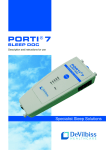
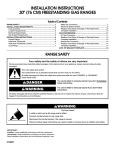
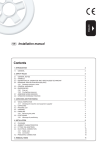




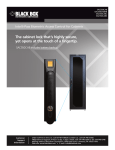
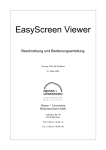
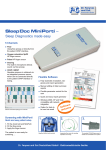
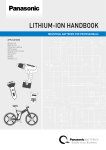
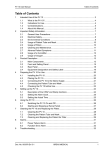
![User`s Manual MV2000[SU:M] Ventilator System 0470](http://vs1.manualzilla.com/store/data/005841388_1-c867b5a0773523e6306e353a41d4c56d-150x150.png)
